new posts in all blogs
Viewing: Blog Posts Tagged with: Graphic Novel, Most Recent at Top [Help]
Results 26 - 50 of 642
How to use this Page
You are viewing the most recent posts tagged with the words: Graphic Novel in the JacketFlap blog reader. What is a tag? Think of a tag as a keyword or category label. Tags can both help you find posts on JacketFlap.com as well as provide an easy way for you to "remember" and classify posts for later recall. Try adding a tag yourself by clicking "Add a tag" below a post's header. Scroll down through the list of Recent Posts in the left column and click on a post title that sounds interesting. You can view all posts from a specific blog by clicking the Blog name in the right column, or you can click a 'More Posts from this Blog' link in any individual post.
 Victoria Jamieson is the author of the superb, Newbery Honor winner this year, Roller Girl. With her newest graphic novel, Pets on the Loose: The Great Pet Escape, Jamieson shifts from the rough and tumble world of roller derby to the dangerous lives of classroom pets. Jamieson's bright palette, way with edgy but cute creatures and attention to details make Pets on the Loose a treat to read - one you will want to read over and over while waiting for the sequel.
Victoria Jamieson is the author of the superb, Newbery Honor winner this year, Roller Girl. With her newest graphic novel, Pets on the Loose: The Great Pet Escape, Jamieson shifts from the rough and tumble world of roller derby to the dangerous lives of classroom pets. Jamieson's bright palette, way with edgy but cute creatures and attention to details make Pets on the Loose a treat to read - one you will want to read over and over while waiting for the sequel.
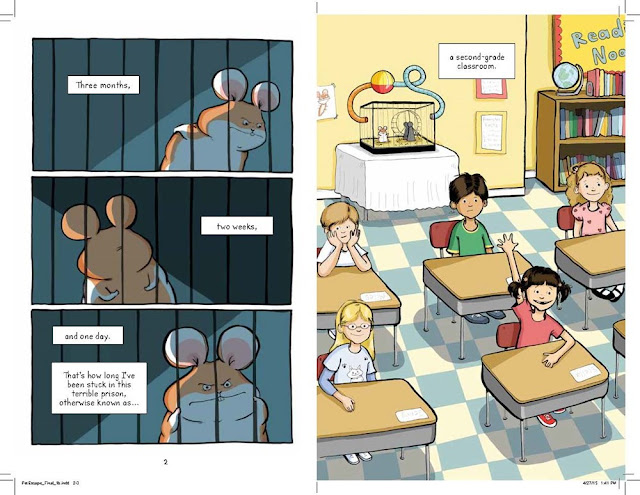
Before we get to chapter one, we get a close up look at the grim life of the narrator, a hamster who has been imprisoned for three months, two weeks and one day in a second grade classroom. Captured along with his friends Biter, a guinea pig, and Barry, a rabbit, GW (short for George Washington, something he is deeply embarassed by) has been plotting their escape. He has invented the Sunflower Slingshot (and there is a hilarious illustration of GW playing the sweet class pet, happily taking a sunflower from the fingers of a student) and the Rodent Catapult Transportation Device.
Things go from bad to worse, including a run-in with Lucinda, the fifth grade pet (a snake) and her minions, the fourth grade pets (white mice) as well as the janitor and a bucket of filthy water. The climax finds the class pets in a very colorful food fight and imprisonment in a ring of green jello. The friends end up back in their cages, ready to plot their takeover of the school from Lucinda and her minions - after they take a nap...
Source: Purchased
Second only to fairy tales, Greek mythology is a favorite of mine. A few years ago, I created a post featuring reference books, story collections and retellings of The Iliad and The Odyssey for kids that you can read here. And, while I love Greek mythology, I am very picky about what I choose to read, give my kids to read and, now as a school librarian, purchase for my students to read. I am grateful to Rick Riordan for making Greek mythology interesting to kids in a huge way, but I am not always happy with the ways that he tweaks the myths. And, while my personal taste does not keep these books - or the graphic editions - off the shelves, I am thrilled that my students share my taste, making George O'Connor's SUPERB Olympians series of graphic novels the most checked out in my library.
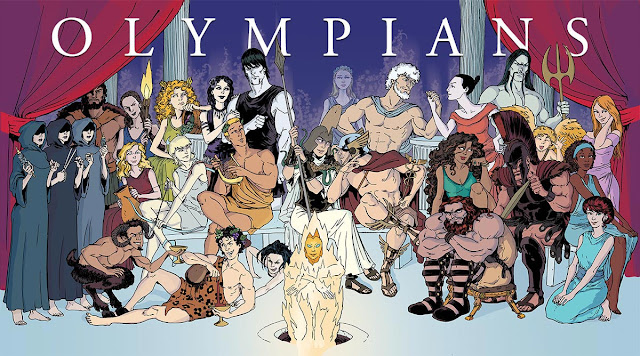
O'Connor is a true scholar of Greek myths and this is evident in each of his books, from the various stories about each god and goddess that he chooses to present in each book to the way he frames these stories and connects them to the excellent back matter, starting with the Author's Note, god/goddess stats, "Greek Notes," which are footnotes that add a wealth of information to the stories, and discussion questions. The frontmatter always includes an extensive Olympians Family Tree. And, while I can't be sure if my students are reading these excellent extras, I do know that they are more likely to consume this information at the end of these graphic novels than they are to pick up D'Aulaire's Greek Myths or other collections, both because of its massive size and outdated appearance. Be sure to visit O'Connor's website, Olympians Rule, where you can read excepts from each book and find more extras to go with each book in the series, like Reader's Theater scripts, an "Add Art or Text" feather that provides a page of illustrated panels with blank speech bubbles OR a page of speech bubbles allowing you to draw in your own gods and goddesses.

O'Connor begins Apollo: The Brilliant One with a quote from The Odyssey, "O Muse! Sing in me, and through me tell a story." Apollo's story begins with one of the Mousai, the nine goddesses of inspiration, or, the Muses. As I read Apollo, I wondered how O'Connor chose the stories that he shares and what order to share them in. Happily, his Author's Note answered that question, which is lengthy but so illuminating. O'Connor writes,
I felt I had to find the thread of what made Apollo compelling, not just as the central character of this book, but as a widely revered god in the ancient world. Ultimately, , inspiration did strike - the nature of the stories told about Apollo is exactly what makes him so interesting to others and to me. He is not some bland, perfect deity; he is conflicted, malicious, and spiteful. He is unknowable in his inhumanity, yet simultaneously relatable. Through research and immersion, the personality of shining Apollo revealed itself to me: an imperfect, proud, brilliant god, resplendent in his glory and unashamed of his pettiness.
For me, O'Connor's description of Apollo also perfectly explains why the Greek myths have endured for thousands of years and are still infinitely interesting and relevant, to both adults and children.
Born of the she-wolf, Leto, and Zeus, Apollo and his twin sister Artemis's birth story is fascinating. As children, they are taken before their father who asked them what "gifts they desired, what they would become." Artemis, who was born first and, in the way that gods and goddesses do, helped Leto deliver her brother nine days later, wants to remain unmarried forever. She wants to hunt with a silver bow and arrows and run wild through the woods with her "own entourage of Oceanides, nymphs and hounds." Apollo refuses to answer. Zeus gives him a "bow to match his sister's. A golden tripod. A chariot pulled by swans to carry him wherever he wished."
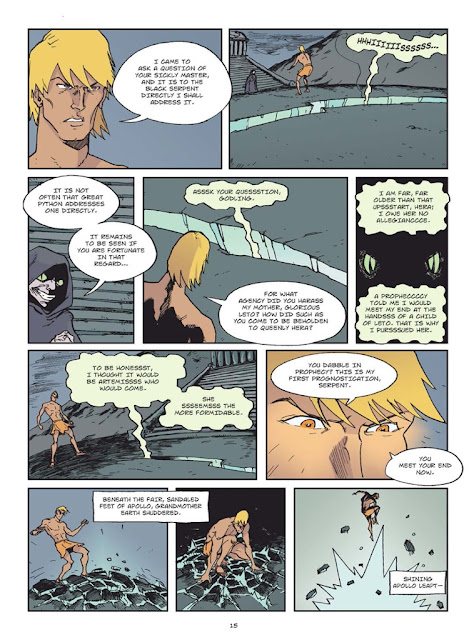
The Muses get a nice bit of page time which includes listing the artistic endeavors they are the inspirations for. The story of Apollo and Daphne, subject of many works of art including Bernini's magnificent sculpture, and the story of Apollo and Hyacinth are both filled with action and emotion. My favorite tale is presented by Clio, the Muse of History, and so much of it is part of our everyday lives today. Apollo fell in love with a mortal woman, the Thessalian princess Koronis. He leaves a white crow to watch over her and, when this crow reports her infidelity, Apollo's rage "scorches the very air around him," which is why all crows are now black. Apollo's ego - and his deep love for his child (another crazy awesome birth story there...) make for a very compelling myth. Turns out, Asklepios, Apollo's son, is raised by Chiron, a centaur and great healer who basically trains Asklepios to be the first human doctor! In turn, Asklepios trains his daughters, Hygeia and Panacea (what what??) to be doctors! Asklepios's sad end is almost as gripping as his strange birth. But I'll leave that for you to discover!
God Stats, found in every book!
Source: Review Copy
When I reviewed Delilah Dirk and the Turkish Lieutenant by Tony Cliff in 2013, I began by apologizing for the reductionist comparison between his insanely awesome character, Delilah Dirk, and Indiana Jones. But the thing is, Delilah Dirk is the closest I have found in all my reading to a girl character that I have no doubt could overcome the supposed reluctance boys have to reading books with main characters who are girls. But, this is all beside the point. The bottom line is that Tony Cliff has created a character and a world that is completely immersive and absorbing. Upon finishing Delilah Dirk and the King's Shilling, I felt as though I had read a 300 page novel and watched a fantastic movie. Seriously, these books are so beyond superlatives. I hope I can write about it coherently enough to convince you to give them a try! Enjoy several pages of Cliff's superb illustrations to find a short summary of book two in what I hope is a long series... 





Of course I don't want to give away too much of the plot of Delilah Dirk and the King's Shilling, but rather tempt you with some key details. Delilah Dirk, daughter of a Greek mother and English father who was a foreign ambassador, allowing him to provide a well traveled and uncommon childhood for his only child, and Erdemoglu Selim, former Turkish janissary and killer tea maker, have been traveling companions for two years. While not avoiding conflict, sword fights and occasional gun battle, the two have been mostly staying out of trouble - until they cross paths with Major Jason Merrick in Portugal where the British are preparing to battle the French in the Peninsular War. Merrick decides to frame Delilah for his treasonous activities and she does not go lightly, taking a bullet to the arm in the process. Of course Delilah and Selim escape and she insists on returning to England to confront Maj. Merrick and restore her reputation. Selim is a loss to understand Delilah's insistence, but he follows her to a country and class of people who assume he is her servant.
Cliff brings great character development to Delilah Dirk and the King's Shilling, both for Delilah and Selim. While there is plenty of action and fight after fight, the personalities, motivations and struggles both face are so compelling - as compelling as Delilah's strong jawline and voluminous hair. And, happily, with her return to England and her familial estate, we get to see where Delilah inherited these physical - and personality traits from!
Delilah Dirk and the Turkish Lieutenant
Source: Review Copy
James Kochalka's Glorkian Warrior and his best buddy Super Backpack debuted in The Glorkian Warrior Delivers a Pizza. In this epic space adventure, the Glorkian Warrior successfully delivered a pizza to himself. In the second book in the series, The Glorkian Warrior Eats Adventure Pie, the Glorkian Warrior is once again his own worst enemy, but this time he has an actual foe - fellow warrior, Buster Glark.
After Buster Glark takes out the the pie factory destroying space snake that he was trying to put an end to, the Glorkain Warrior and Super Backpack find their way home where they are greeted by Gonk, a mini-me version of the Glorkian Warrior and a lime green baby alien who affixes himself firmly to GW's head and makes a sucking sound.
Some serious absurdity ensues, including rearranging the furniture by flipping it upside down, a poke in the eye for Gonk, a consultation with Mr. Elbow and backpack for Gonk made from the house phone. The gang head out for Glork Patrol but, of course, things don't go as planned. GW falls over, from extreme hunger or from the baby alien sucking all his brains out, leaving Gonk and Super Backpack to save the day.
Not an easy task by any means, things get even more complicated when Buster Glark returns and uses a freeze ray on the baby alien. Ships are crashed, holes are made, elbows are thrown and, incredibly, the baby alien attacks the Space Snake resulting in the head crashing down right in front of the gang and spitting out pieces of pie!
Kochalka's sense of humor (and plotting) is completely bonkers and perfectly paired with the Easter egg colors of his illustrations. There are fart jokes, a few butt jokes and all sorts of ludicrous antics that kids love. The Glorkian Warrior Eats Adventure Pie might not be everyone's sense of humor, but for those who dig it, it's a stellar treat!
Source: Purchased
Books 1 & 3 in the Glorkian Warrior Series!
Coming in March!
The Glorkian Warrior and the Mustache of Destiny

I have been half-writing (mostly in my head) a review of the first book in Philip Pullman's masterful trilogy, (known collectively as His Dark Materials) The Golden Compass, originally published in the UK with the title Northern Lights, since I started this blog in 2008. Like the other books that have meant a tremendous amount to me as an adult and/or as a child (Harry Potter, The Phantom Tollbooth) I have not reviewed them here, either because I wasn't sure I could add anything new to the conversation or because the task was too overwhelming. A review of Pullman's almost 20 year old book falls into both categories. Contemplating writing a review of this philosophically provocative, theologically challenging brilliant work of fantasy (really - dæmons? The best fantastical creation ever!!) feels comparable to starting my thesis senior year of college. What follows is a review of the graphic novel with a brief synopsis of the plot of the graphic novel adaptation (but not the whole book) for readers who have not had the immense pleasure of reading this trilogy yet. For an encompassing review of all three books in one, read Brian Anderson's review of The Amber Spyglass for the New York Times.

But, as a fan of the graphic novel, I think I just might have something to say about this new adaptation of Pullman's work. First of all, I think that the only logical choice was to have this illustrated adaptation creation taken on by the French. I learned years ago that the French love, love, love and have deep respect for the art of the graphic novel. And, last summer over the course of a few days in Paris, I visited many bookstores and several spent hours in the graphic novel sections regretting the fact that I had forgotten all of my high school French but marveling over all the gorgeous, inventive visual storytelling. Another smart choice was made when this book was divided into three volumes, with books 2 and 3 coming out in September 2016 and 2017.

I also think that I am perfectly poised to review the graphic novel adaptation of The Golden Compass because I first read the trilogy about 16 years ago, just before the third and final book, The Amber Spyglass, was published. Since then, I have listened to the fantastic audio production of the trilogy (including a full cast with Pullman himself narrating) a couple of times. So I remember the book, but not enough to get really picky about the adaptation itself, which would detract from enjoyment of the graphic novel. Of course aspects of the plot have to be simplified and speeded up because this is a graphic novel - and because of the complexity of the themes. Melchior, who also wrote the graphic novel adaptation of The Great Gatsby (Gatsby le Magnifique) does a fine job explaining the fantasy elements of the novel, like dæmons, the alethiometer and panserbjorne, while Oubrerie's illustrations bring the familiar but strange world of an England and Northern Europe to life. For me, Pullman's novels are so richly magical and polished (they are often ranked alongside the works of C.S. Lewis and Tolkein) that I think I might have imagined a more lush illustration style, like that of Kazu Kibuishi. But, Oubrerie's scratchy, kinetic style captures the almost feral nature - and enthusiasm - of Lyra and the archaically civilized world of Jordan College that brushes - sometimes roughly - against the natural world around them and the various tribes that inhabit it.

Of course there are aspects of the novel that I found missing in this graphic adaptation, but this is also a three part adaptation of a single book. I am hopeful that things I noticed missing - like the compelling relationship between dæmons and their humans - will be explored in the next book as we move closer to Svalbard and the Northern Lights. However, as sometimes only a graphic novel can do, there are winks and nods as well. In one scene, Lyra and Pan are in the heart of the city at night and they pass a theater where John Milton's Paradise Lost is being performed, a nod to the title of the trilogy, taken from Book 2 of Milton's epic poem.

The Golden Compass: The Graphic Novel, Volume 1 begins with a zeppelin hovering over Oxford, preparing to dock at Jordan college where Lord Asriel, the great explorer, is due to give a talk about his travels in the North. Hiding in a cupboard with her dæmon Pantalaimon, is Lyra Belacqua. So much happens in this one scene - Lyra saves Lord Asriel, a man she believes is her uncle and benefactor, from being poisoned. She also overhears Asriel's discussion of Dust and the appearance of another world through the glimmering Northern Lights. From that night, the story takes off at a fast pace. The head of Jordan College sends Lyra off to live with Mrs. Coulter, an elegant explorer with connections to people in high places, such as the Magesterium and the General Oblation Board, also known as the Gobblers. Before Lyra leaves Jordan College, the Master gives her the alethiometer, a golden compass that Lord Asriel entrusted to him, telling her to keep it hidden. When Mrs. Coulter's dæmon finds it, Lyra and Pan make a quick escape. A dangerous night leads them to a gyptian boat and safety. Hidden amongst this community that has lost many of its children to the Gobblers, Lyra finds her place and a deeper understanding of the alethiometer as they sail towards the North to make a dangerous rescue.
Book 2 of The Golden Compass Graphic Novel, coming September 2016
(the French cover, which reflects the original British title, The Northern Lights)
Melchior's graphic novel adaptation of
The Great Gatsby

By: Kenneth Kit Lamug,
on 1/17/2016
Blog:
RabbleBoy
(
Login to Add to MyJacketFlap)
JacketFlap tags:
sam bosma,
Comics / Graphic Novels,
fantasy sports,
norbrow,
Book Reviews,
graphic novel,
comics,
manga,
art,
anime,
picture book review,
Add a tag
This is a book preview for FANTASY SPORTS #1 by Sam Bosma. In Sam Bosma’s debut graphic novel, a young explorer and her musclebound friend…
Friendship, connection, danger, adventure, robots or creatures. These are things you can count on in a Ben Hatke book, and these are the elements that I look forward to experiencing through his particular perspective (and paintbrush) with each and every book. In his newest graphic novel, Little Robot, Hatke tells the almost wordless story of a little girl who finds and fights to keep her new friend.
A box falls out of a truck and off a bridge, making its way to a junkyard downstream. A little girl slips out of the window of her trailer home and heads off into the wilds/junkyard, shoeless, where she unearths her tool satchel. There she discovers the box and the robot within.
After getting the bot going, she helps it to master the art of walking. Together the two explore as she gently teaches the robot about the world around them. In a factory far away we see an alarm going off - a robot is missing. A massive, one eyed, multi-legged, yellow behemoth is seen trundling out of a hangar and into the distance. A capture, a rescue and a dramatic ending leave the little heroine with more bots and friends than before along with a very satisfying ending.
Being mostly wordless, Little Robot is so much about feelings and the sometimes wordless connection of friendship. Little Robot is a "meditation on friendship more than a lesson," as Hatke said of his book in an interview with EW. Hatke goes on to say that his heroine is, "a hero for the introverts and the makers." And, while this is a graphic novel about robots, junkyards and machines, the natural world is very much a vivid part of Little Robot. Hatke says that this scenery is "partially inspired by and informed by the landscape around my home in Virginia. The rural area in the Shenandoah valley." Amidst the green fields are forests are cats, birds, frogs, ducks, turtles and newly blooming flowers. There is a six-panel page where the girl and the bot come across a dead squirrel. "XoNX," the bot exclaims (the bot has a fantastic phonetic language, "Jonk," being its most frequent verbalization) and the little girl, completely at home in the natural world, reassures him, "It's just dead is all."
For a book with so few words, there is so much going on in Little Robot. But this is always the case with Hatke's books. His illustration style, color palette, characters and plots are good. That seems like a tired, less than celebratory adjective but I mean it in the best, truest sense of the word possible. If you have ever read Hatke's blog or had the immense pleasure of viewing his wife's Instagram feed, you will experience the well of goodness, from good living to good parenting and educating to good stewardship of and connection to the natural world, that Hatke's creations arise from and/or are fueled by. This is a good world that I want to live in and one that I want the young readers I teach to live in, even if we can only get to it from the pages of his books.
A new picture book coming from Hatke this year!
And a new graphic novel coming next year, maybe...
Source: Purchased
I can't ever imagine getting tired of Barry Deutsch's self-possessed, stubborn heroine or the slightly As one review succinctly, perfectly signed off, "This consistently clever and thoughtful series has not lost a particle of momentum." One of my favorite little things that comes with each new book is the new tagline! For book three in this brilliant series,
Hereville: How Mirka Caught a Fish, the it reads, "Yet Another 11-Year-Old Time Traveling Orthodox Jewish Babysitter." As always, Deutsch's books are a marvelous mash-up of a fairy-tale-fantasy world and an Orthodox Jewish community. With book three, we get a glimpse into the world of Fruma, Mirka's stepmother.Just before leaving Mirka home alone to babysit her little sister Layele, her stepmother Fruma drops some cryptic comments about happenings in the woods near their home. Tasked with doing the Shabbos shopping at Hershel's Grocery, Mirka drags a frightened Layele into the woods first so that she can get help in finding out what Fruma meant. A very funny scene with the troll Mirka fought in the first book ends with a magic hair tie that affords Mirka and Layele to see Fruma as a teenager. A non-Orthodox teenager!

A magic fish, a wish made by teen-Fruma and a tricky second wish that traps the fish cause trouble for Mirka and Layele, who finds herself the vessel for the fish at one point. The fish is determined to exact revenge on Fruma and Mirka finds that she has to use her brain and her empathy instead of her sword to outwit the vindictive fish. Mirka is a compelling character both because of her flaws and her strengths. She is headstrong and determined and always breaking rules and disregarding her elders, and for this I love her. But what I love even more is watching Mirka think (and fight) her way to redemption and success.
Books 1 & 2 in the Hereville Series:
Source: Review Copy
Binary code. Computer programming. New town and new school. Gene Luen Yang, graphic novelist extraordinaire, is great storyteller, whatever subject he focuses on. Yang moves with ease from literary historical fiction like Boxers & Saints, to superheroes, like The Shadow Hero, Avatar, the Last Airbender and Superman, and on to everyday life, like Level Up, American Born Chinese, and The Eternal Smile. As a former high school computer science teacher, who made comics at night, Yang is a big supporter of teacher kids to code at an early age and his newest graphic novel series, Secret Coders: Get With the Program!, created with Mike Holmes, bringing what Yang calls a "Saturday morning energy" to it, does just that.is designed to do just that. There is even an excellent website for the book filled with great instructional videos, coding activities, including a downloadable file that lets you create Little Guy, the robot from the book, on a 3D printer! Stately Academy, the setting of Secret Coders: Get With the Program!, is a bit like Hogwarts. As Yang says, it's a secret school that "teaches coding instead of magic." And, as Yang points out, coding is even better than magic because you can do it at home! Hopper is new to the slightly creepy, sort of mysterious Stately Academy. She gets pudding chucked at her head, makes a fool of herself in Mandarin class and at lunch her earrings, shaped like the number 7, trigger a startling reaction in a weird bird.

Seeing this oddity, Eni, son of a software engineer, comes over to investigate. Besides having some mad skills on the basketball court, Eni has a solid grasp of binary numbers and explains the controlling binary code to Hopper with a cool demonstration using pennies and chalk. Once Hopper gets it, the two experiment on the bird and begin to understand why the number 9 appears all over the school. There seem to be secret codes everywhere at Stately Academy and as Eni, his buddy Josh and Hopper break them they travel deeper and deeper into the secrets of the school and the crusty old janitor, Mr. Bee.
 Some secrets are exposed and even more are unearthed by the end of Secret Coders: Get With the Program!, which has a bit of a cliffhanger. Book 1 is a great set up, focusing on making sure that readers understand binary code (over more character and plot development) before moving on to the next book in the series, Secret Coders: Paths & Portals, which comes out in January of 2016!
Some secrets are exposed and even more are unearthed by the end of Secret Coders: Get With the Program!, which has a bit of a cliffhanger. Book 1 is a great set up, focusing on making sure that readers understand binary code (over more character and plot development) before moving on to the next book in the series, Secret Coders: Paths & Portals, which comes out in January of 2016!
Source: Review Copy
By: Stacy Dillon,
on 12/6/2015
Blog:
Welcome to my Tweendom
(
Login to Add to MyJacketFlap)
JacketFlap tags:
family,
Friendship,
graphic novel,
superheroes,
Scholastic,
grandparents,
addiction,
2015,
library copy,
Add a tag
Every now and again you come across a perfect book. Of course there's no such thing as perfection for everyone, but for you as a reader, the right book lands into your hands at the right time. This is how I feel about the Holm's Sunny Side Up.
It's 1976 and Sunny Lewin is being sent down to Florida to spend some time with her Grandpa. But where Gramps lives is no Disney World ... it's a retirement community where Sunny has to wear an ID at all times to prove that she belongs there.
Luckily, Sunny isn't the only kid in the community. The groundskeeper's son Buzz lives there as well. He is totally into comics and introduces Sunny to some of his favorites while she's in Florida. The two of them manage to make some money finding lost cats for the old ladies, and golf balls for the pro shop to fund their comic habit.
These all seems rather bucolic and idyllic on the surface, but readers learn through Sunny's flashbacks that there is a reason that she is spending time with Gramps far from home. It turns out her older brother is experiencing problems with addiction. Sunny doesn't understand what's really happening -- she just knows her brother isn't who she remembers him to be and he's causing all kinds of trouble for their family.
Handled deftly, Sunny's confusion and concern are heartbreaking. Based on true events, the authenticity in this title stands out. The push pull of Sunny's feelings for her brother are obvious and none of the characters are one note. Little things like the toilet roll doll and lifting buns from the early bird special may go over younger readers' heads, but are perfect for the setting and the time period.
I borrowed our copy from the library, but will be purchasing this one to live on my shelves. I can imagine future me pulling it from the shelf and shedding a tear or two each and every time.

By:
Heidi MacDonald,
on 12/1/2015
Blog:
PW -The Beat
(
Login to Add to MyJacketFlap)
JacketFlap tags:
Graphic Novel,
Comics,
DC,
Breaking News,
Publishers,
Vertigo,
Top News,
Top Comics,
Paul Dini,
Dark Knight: A True Batman Story,
Add a tag
The best works of fiction usually have some basis in reality. Paul Dini is teaming up with Eduardo Risso to tell a Batman story inspired by a mugging in 1993. Dark Knight: A True Batman Story is an original graphic novel told by the two storytellers. The book will be published via DC Comics’ Vertigo […]


One thing I love about all three of the books Duffy has edited are the international tales, fables and rhymes that he includes in each book. While many of the fables in Fable Comics are Aesop's, Angola, India and the work of American author Ambrose Bierce and Russian satirist Ivan Krilof are included. As Duffy's editor's note tells us, "A fable is a story with a lesson, usually - not always - starring animals. The lesson can be stated or it can be something to figure out. But they are, in essence, bossy stories with a message for you." This has to be one of the best characterizations ever. He also notes that the cartoonists were allowed to "embellish the stories (as they like to do)" but he made sure that the integral lesson of the fable remained. These embellishments, along with a glorious variety of illustration style, is what make all three of the books in this series so much fun to read over and over. If you don't own any of these collections, Fable Comics is a great place to start. If you already own Nursery Rhyme Comics and or Fairy Tale Comics, then this new book is a must!



The other two excellent books in this series:
Source: Review Copy
Jane, the Fox and Me is a graphic novel by Fanny Britt, illustrated by the marvelous Isabelle Arsenault, but it feels like something different. The trim size of Jane, the Fox and Me is big, like a picture book. The handwritten text shifts from block letters to cursive to a delicate font just as the story shifts between worlds when Hélène, the young hero of the story, moves between the worlds of school, home and her inner life, fueled by her literary explorations that shape how she sees the world. Like the grey and sepia tones of most of Aresnault's illustrations, Hélène's worlds are bleak. School is a lonely landscape where she is taunted by mean girls. Flashbacks reveal that it wasn't always this way, once she had friends and was part of a group of girls who loved shopping vintage stores for crinoline dresses. Home is not much better, with her younger twin brothers and her overworked mother. Escape comes in the pages of Jane Eyre and the world of Thornfield Hall. 


Everyone knows that kids are mean and will find (or create) a weakness in another child to prey on. Hélène's former friends ostracize her because of how she looks, writing graffiti on the walls of the bathroom about her weight and body odor. Britt handles this delicate subject with simplicity and honesty that speaks to the core of any girl who was (is) not slender and hopefully opens the eyes to those who are. Britt crystalizes the experience of being overweight when Hélène learns that her class will be going to nature camp, necessitating the purchase of a new swimsuit and her only options are a ruffled, skirted suit and one that is "all black and sad." Hélène sees herself as a sausage in a swimsuit.
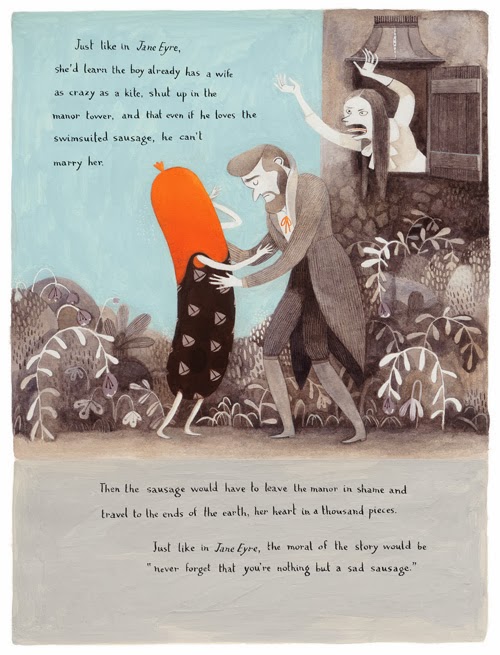
Hélène departs, "on a bus to Lake Kanawana with forty kids in shorts, not one of them a friend." The mean girl, fat shaming escalates at camp, where Hélène ends up in the outcasts' tent, believing that the moral of Jane Eyre and her own story is, "never forget that you're nothing but a sad sausage." When things seem at their lowest for Hélène, Géraldine appears and a friend is made. And, while Hélène finally finding a friend again is a wonderful plot thread, I especially appreciated how Britt ends Jane, the Fox and Me, with a visit to the doctor for an annual exam. Stepping on the scale, Hélène sees that she weighs less than the graffiti, but more than last year and claps her hands to her head and shrieks, the way she sees her mother (and the lady in the cereal ad) do when she steps on the scale. She tells the doctor that she is fat and the doctor tells her she is no such thing. Her mother asks where she ever got the idea that she was fat and, in her head Hélène ticks off the many places, including her own mother, but does not say them out loud. She realizes that the less she thinks about what other people say about her, the less it is true. I wish that every lonely, book loving, less that slim young girl could read Jane, the Fox and Me and think less about what is not true.

Source: Purchased at Porter Square Books
in Somerville, MA
Check out the cover for Richard Van Camp's A Blanket of Butterflies:
Gorgeous, isn't it?
A Blanket of Butterflies, illustrated by Scott B. Henderson, is new this year (2015) from Highwater Press, an imprint of Portage & Main Press in Canada. That sword? It is a key piece of this story.
When you open the cover, here's the first page:
As the story opens, Sonny is at the
Northern Life Museum in Fort Smith, Northwest Territory. He's looking at a samurai suit of armor when he notices a man who is also looking at it. The man's name is Shinobu. See the paper he's pulling from his coat? He's at the museum with a specific purpose: to pick up that suit. It belongs to his family. The museum staff worked to identify who it belongs to, and then got in touch with Shinobu's family.
I gotta say--I love how Van Camp's story gets going--and here's why. So many things in museums are there due to theft and exploitation. Grave robbing of Native graves is rampant. Native protests led Congress to take action. In 1990, Congress wrote the Native American Graves Protection and Repatriation Act to help tribal peoples reclaim remains and artifacts (see the
FAQ). That law, and
A Blanket of Butterflies, is all about dignity and humanity, for all peoples.
Back to the story...
There's something missing from the display. A sword. Shinobu learns where it is and sets out to get it, but Sonny knows where it is, too, and he also knows that it is risky for Shinobu to go there alone. Sonny follows him, and strikes up a conversation, noting that Shinobu has a butterfly tattoo on his hand. Things don't go well. Shinobu gets hurt...
Yesterday (Friday, November 14) I listened to
Acimowin on CJSR, an independent radio station in Edmondton, Canada. The guest? Richard Van Camp. I listened to him talk about
A Blanket of Butterflies and wish you could have heard him, too. There's a grandma in this story. She's the hero. Hearing him talk about her... awesome.
Get a copy of
A Blanket of Butterflies for your library or classroom, or for your own young readers. I really like it and highly recommend it.
And--check out that weekly radio show,
Acimowin, too, on Friday mornings. You can listen online. One of the best things people who write, review, edit, or publish children's and young adult literature can do, is listen to Native voices. Learn who we are, and what we care about. It'll help you do a better job at writing, or reviewing, or editing, or selecting, or... deselecting! Acimowin is hosted by Jojo, who tweets from @acimowin. I laughed out loud more than once, listening to the banter between these First Nations people... (Note: the radio show is not for young kids.) Love the graphics for the show!
The Other Side of the Wall by Simon Schwartz
Translated from German by Laura Watkinson
Published by Graphic Universe, 2015
112 pages, best for grades 6 and up
Paperback
Simon Schwartz was born in East Berlin in the 1980s
.The Other Side of the Wall is his graphic memoir of growing up in the divided city, of his parent's three-year struggle to obtain an exit permit to leave East Berlin, and of his later forays between the two Berlins.
His parents met in college. His father came from a family of staunch Communist Party members. His mother's family was secretly more liberal, though any deviation from expected Party behavior was cause for examination and surveillance by the Stasi, or secret German police. It was dangerous to stray from party orthodoxy, particularly if you were a teacher, as Simon's father was. His parents became disillusioned with life in the restrictive East German city.
The Soviet Union had recently invaded Afghanistan. My dad worked on his speech, night after night.
"God, how can you describe a war as just? They want me to use fancy words to justify this invasion."
"Just write something you can square with your own conscience -- at least in part."
"I don't know if I can do that."
When his parents requested exit permits, their lives became fraught with poverty,ostracism, and physical danger.
The book's layout is as structured as Communist life - with few exceptions, four blocks per page - each bordered in black. The artwork is monochromatic, fitting for the stark reality of life behind the Wall. The story is told in speech bubbles, text blocks that set the scene or relay back story, and the occasional footnote explaining terms that may not be familiar to readers (well-known politicians or artists of the time, and uniquely German or Communist terms). Several panels are wordless - vague remembrances of the young Schwarz.
Back matter includes a glossary, a timeline of the Berlin Wall, and maps of Germany and Berlin 1961-1989.
I recently reviewed the historical fiction novel,
A Night Divided, that describes life in East Berlin in the immediate aftermath of the Berlin Wall's construction.
The Other Side of the Wall is a perfect companion book - a nonfiction, graphic novel account of the Wall's waning days. For younger readers not familiar with day-to-day life in the Cold War Era, this is a chilling introduction.

By:
Sue Morris @ KidLitReviews,
on 10/26/2015
Blog:
Kid Lit Reviews
(
Login to Add to MyJacketFlap)
JacketFlap tags:
Graphic Novel,
Comics,
Middle Grade,
Series,
Nickelodeon,
Books for Boys,
Viacom,
4stars,
Papercutz,
Library Donated Books,
Sanjay and Craig#1: Fight the Future with Flavor!,
Add a tag
Sanjay and Craig #1: Fight the Future with Flavor! Written by Eric Esquivel Illustrated by Ryan Jampole, James Kaminski, Sam Spina Papercutz — Nickelodeon 9/22/2015 978-1-62991-302-5 56 pages Age 8+ “Nickelodeon’s animated television series Sanjay and Craig follows best buds Sanjay Patel and Craig Slithers as they embark …
2015, HarperCollins
Take one slightly OCD supervillain with a penchant for science, one golden knight who works for the Institution of Law Enforcement and Heroics, and one superbad shape-shifter girl.
Swirl it all with a heavy dose of sarcastic humor, a heaping of death and destruction, and a taste of the days of Lancelot with a hint of today's science technology.
Read for a day (or two) and you'll see what an OUTSTANDING graphic novel this is!!
Ballister Blackheart is a supervillain. He's created not only a name but a reputation for being the nemesis of the kingdom's golden boy, Sir Ambrosius Goldenloin (and the humor begins...). They've been fighting for years because of a joust gone wrong and nothing will mend the friendship they once shared.
And then along comes Nimona. Such a cute girl with red hair...and a penchant to want to destroy, kill and maim. She's a shapeshifter, and can replicate into anything in order to help Sir Blackheart take over the kingdom. But there are a few slight problems.
He wants control and order, she lives in chaos.
He's not into hurting or killing people, she doesn't think twice about not doing it.
He's a seasoned veteran, who's been working on his reputation for awhile. She's a young newbie, with lots of enthusiasm and curiosity.
Together, they are beginning to tear the kingdom apart (even though she's allergic to bananas and can hardly watch a scary movie), especially after they find out what the Institution is truly up to.
The Director assigns Sir Goldenloin the task of killing the girl and capturing Blackheart, but he's not sure he can do it. Go against the Institution and lose his place of glory or kill a little kid? What's a knight to do?
Stevenson creates a graphic novel which not only tells a great story, but also brings about fits of laughter. Her art is a spot-on delivery of building and creating characters and their personalities the reader understand through through the artwork Stevenson creates. She carries it forward not only through artwork, but the subtle ways the characters interact and speak to each other all while an exciting tale is told. No wonder this was nominated for the National Book Award....it's truly an excellent GN! HIGHLY recommended for JH/HS
The Stratford Zoo Midnight Review series by Ian Lendler and Zack Giallongo is going to do for Shakespeare what George O'Connor has done for Greek mythology with his Olympians series. Last year they debuted, The Stratford Zoo Midnight Review Presents: Macbeth, and now, as promised by the peacock at the end of Macbeth, The Stratford Zoo Midnight Review: Romeo and Juliet has arrived!
The Stratford Zoo Midnight Review Presents: Macbeth takes a pretty intense, adult play about a thirst for power, a prophecy and more than a few murders and, miraculously, makes it kid appropriate. As The Stratford Zoo Midnight Review Presents: Macbeth begins, there is a quick set up where readers see a pink, tentacle-y arm unlocking cages all over the zoo and the audience taking their seats while seagulls hawk "Peanuts! Earthworms! Ice cold bananas!" and, "Carrion, rotting carrion!" Panels, sometimes strategically placed, allow glimpses of the audience and their reactions as the play unfolds.

Macbeth, as played by the lion, is adored by all, plied with food and hungry for something new. He realizes that if he eats the king he will become the new king. It's not food Macbeth wants, it's power! Loads of ketchup and an elephant getting up out of his seat disguise the murders that Macbeth commits to become and stay king. Lady Macbeth, as played by a cheetah, realizes, most dramatically, that her spots just will NOT come out (and a key word in her famous speech about them is changed to "dumb.") MacDuff, as played by a stork, defeats Macbeth, fulfilling the prophecy because he wasn't born from a mother, but "delivered," and, happily, everyone that he has eaten in his quest for power pops out of his mouth! The actors take a bow, the audience leaves and, as the zoo opens we see kids wondering what the animals do all night, since they seem to sleep all day...

In The Stratford Zoo Midnight Review: Romeo and Juliet the animal actors return with another of Shakespeare's tragedies and a rooster and a bear in the titular roles. The same family of monkeys return for the play, and the little one quips and complains and tussles with a lamb, Lydia, but ultimately enjoy the play and find friendship after the curtain closes, echoing that action on the stage. The writing and casting of The Stratford Zoo Midnight Review: Romeo and Juliet is brilliant. Romeo and the Montagues are roosters (and chickens) and part of the Verona Petting Zoo and known as "Petters." The Capulets are Wilders, bears living in the wilderness. The two meet at a costume party where Romeo is wearing a bandit mask and Juliet is dressed as (a very cute) Abraham Lincoln. Lendler gets around the love, marriage and death aspects of the story by having Romeo and Juliet want to be best friends and Juliet deciding to enter into early hibernation.

 Giallongo's illustrations are bright and colorful and hilarious. The plans for Juliet's party include juice boxes and a blow-up bounce house. The Stratford Zoo Midnight Review: Romeo and Juliet is a more brightly colored book, perhaps because of the roosters. Once again, the violence and death is tactfully handled by having an elephant in the audience - this time with a date in tow - stand up and block the stage. The story and art work together perfectly, once again, in this totally entertaining graphic novel. Kids don't need to know that they are reading a Shakespeare play to enjoy or understand the story - it works on its own. The bonus is, maybe 5 years down the road when they read the play in high school, they will already know the story! Once again, the zookeepers clean up after the play, baffled by a bottle of "Hibernation Juice" they discover amongst the trash. The next play/graphic novel promises to be a comedy and I can't wait to read it.
Giallongo's illustrations are bright and colorful and hilarious. The plans for Juliet's party include juice boxes and a blow-up bounce house. The Stratford Zoo Midnight Review: Romeo and Juliet is a more brightly colored book, perhaps because of the roosters. Once again, the violence and death is tactfully handled by having an elephant in the audience - this time with a date in tow - stand up and block the stage. The story and art work together perfectly, once again, in this totally entertaining graphic novel. Kids don't need to know that they are reading a Shakespeare play to enjoy or understand the story - it works on its own. The bonus is, maybe 5 years down the road when they read the play in high school, they will already know the story! Once again, the zookeepers clean up after the play, baffled by a bottle of "Hibernation Juice" they discover amongst the trash. The next play/graphic novel promises to be a comedy and I can't wait to read it.

Source: Purchased (Macbeth) and Review Copy (Romeo & Juliet)
by Alex Dueben For the past few years Maggie Thrash has been writing fiction and nonfiction at the acclaimed Rookie Magazine. Her first book, Honor Girl: A Graphic Memoir, details a single summer at camp which Thrash described as the most important few months of her life because she comes out as queer while nursing […]
Today, First Second Books releases The Fall of the House of West. The book is the newest installment in the acclaimed series of graphic novels that includes Battling Boy and The Rise of Aurora West. In it, writer Paul Pope, co-author JT Petty, and artist David Rubin return to Aurora’s story in a tour de force that mixes sci-fi, fantasy, manga, […]
HMH Young Readers, 2015
I picked up this graphic novel because I was intrigued not only by the cover, but by how this non-fiction GN would stack up to what happened....I wasn't disappointed.
At this moment in time, there are two very significant historical moments high school students have lived through and will tell their grandchildren they were alive when it happened. Most students can tell you about the 9/11 tragedy because there is a memorial set up, it's been televised and Youtubed, and schools usually honor those who died every year.
When asked what the other significant historical moment happened during their lifetimes, most had to think about it until I showed them the cover of the book. Don Brown, who wrote and illustrated this GN, tells the tragic story of not only Hurricane Katrina the natural disaster, but also the tragedies that happened to those who stayed, the heroes and the villains, and how this natural disaster was SO overlooked not only by the state, but also by the federal government. Brown's illustrations depict the sadness and desperation people felt, from those at the Superdome to those trapped in their homes, to the patients in hospitals left behind and based on factual evidence.
Brown also injects sad truth into the book as well. Authorities in charge of the city from the top down weren't available or around during the aftermath. Some in the police force abandoned their posts and the companies who volunteered their services before the hurricane hit to transport those who couldn't get out were turned away...but there were the unknown heroes as well, who used their boats and other water vehicles to help those stranded on their rooftops.
While booktalking this book last week, I asked students to recall the heat in Texas in August, when temperatures easily reached into the 100s. Would they be able to stand on a paved road for 24 hours with little or no water or food? Coupled with extreme humidity, raw sewage, toxic water and the smell of death in the air....that's what people went through who were left behind.
This is the powerful image Don Brown creates, not only physically but emotionally as well. And it is also something students need to know more about instead of compartmentalizing it as another hurricane that wrecked a city.
This is an important book to have in any library because it tells a story needing to be told in a format conveying more than words on pages. Highly recommended.
Some may not consider graphic novels a teaching tool, but in recent years graphic storytelling has been used as a medium to explore different kinds of stories for broader audiences. Because of this, these books are finding their way into more and more classrooms and libraries.
Why teach with graphic novels?
- Kids love them – even the most reluctant readers
- They build visual literacy and require readers to use both sides of their brains
- They offer visual support that can aid reading and comprehension for English language learners and kids with some learning disabilities, such as Dyslexia
- They inspire kids to create their own stories
- They deliver rich stories with terrific art – a winning combination
Looking for just the right graphic novel for your young reader? Here are a few of our favorites:
For Kindergarten – 2nd Grade
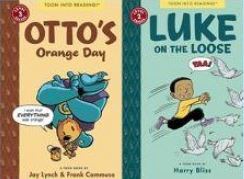 TOON publishes fun comics that early readers can read by themselves or side-by-side with an adult, and each is vetted by literacy experts. With original stories, quirky characters, and plenty of age-appropriate wit, TOON Books enthrall both the emerging and reluctant reader. Every book has been vetted by literacy experts to ensure the language and narratives are appropriate for independent readers.
TOON publishes fun comics that early readers can read by themselves or side-by-side with an adult, and each is vetted by literacy experts. With original stories, quirky characters, and plenty of age-appropriate wit, TOON Books enthrall both the emerging and reluctant reader. Every book has been vetted by literacy experts to ensure the language and narratives are appropriate for independent readers.
For 2nd – 4rd Grade
 Hamster and Cheese (Guinea Pig, Pet Shop Private Eye Series #1) Written by Colleen AF Venable; illustrated by Stephanie Yue
Hamster and Cheese (Guinea Pig, Pet Shop Private Eye Series #1) Written by Colleen AF Venable; illustrated by Stephanie Yue
Ingredients: a guinea pig who solves crimes, a pet shop full of entertaining animals, and a missing sandwich. Put them all together and you get this hilarious graphic novel, the first in a wonderful series. It’s a great pick for readers of early chapter books, animal lovers, and/or detectives in training.
For 4th – 6th Grade
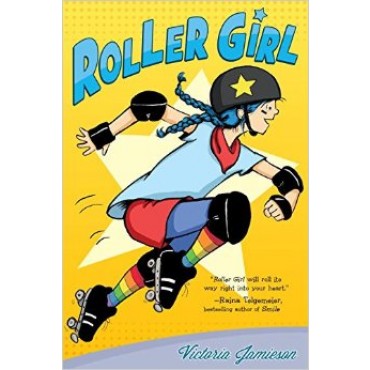 Roller Girl Written and illustrated by Victoria Jamieson
Roller Girl Written and illustrated by Victoria Jamieson
Yes! A roller derby graphic novel for kids! This delightful book tells the story of a girl who is learning how to stay on her feet – both on roller skates, and in friendship. The story is engaging, the art is super appealing, and adults will love the book’s subtle, underlying advice about how to be a good friend and a good son or daughter.
For 5th – 8th Grade
 Nathan Hale’s Hazardous Tales: The Underground Abductor Written and illustrated by Nathan Hale
Nathan Hale’s Hazardous Tales: The Underground Abductor Written and illustrated by Nathan Hale
The newest book in one of our favorite series is a true show-stopper. Just how much do you know about Harriet Tubman? The facts contained in this biographical narrative will blow your mind. It’s captivating, entertaining, and will make your kids eager to learn even more about American history and one of its most remarkable heroes.
For 8th Grade – Adults
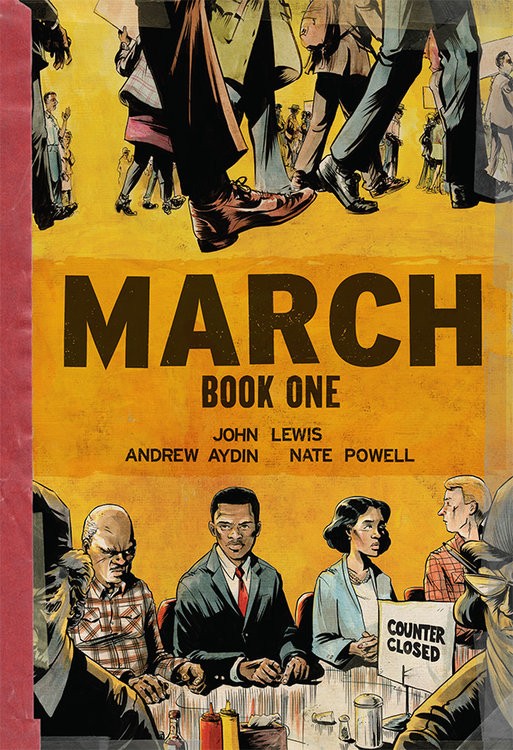 March: Book One and March: Book Two Written by John Robert Lewis and Andrew Aydin; illustrated by Nate Powell
March: Book One and March: Book Two Written by John Robert Lewis and Andrew Aydin; illustrated by Nate Powell
These remarkable, New York Times-bestselling graphic novels belong in every program serving young adults! Congressman John Lewis recounts his role in the Civil Rights movement, introducing readers to pivotal moments that changed a nation. Readers follow his personal experiences and learn the motivations of the heroic young men and women who waged a war against segregation.
Members of First Book’s community of educators who have used graphic novels in the classroom can attest to the fact that they can reinforce new vocabulary, visual literacy, and reading skills. If you work with kids in need, you can find these graphic novels and more on the First Book Marketplace.
The post 5 Reasons to Teach with Graphic Novels appeared first on First Book Blog.

Sunny Side Up by Jennifer L. Holm and Matthew Holm is a magnificent semi-autobiographical graphic novel that can stand next to the works of Raina Telgemeier and Newbery Honor winner, Cece Bell, author of El Deafo. Based on book sales and the check out rate of these titles in my school library, girls and boys are hungry for graphic novels like Smile, Drama and Sisters that tell the stories
Eleanor Davis has created two of my all-time favorite graphic novels, the multiple award winning Stinky, one of the first TOON Books published in 2008, and Secret Science Alliance, which came out in 2009. After creating art and a graphic novel for adults, Davis and fellow graphic novelist and husband Drew Weing have teamed up with each other and TOON Books to bring us Flop to the Top.
In 2012, David Nytra's The Secret of the Stone Frog kicked off the TOON Graphics series for visual readers. At a higher reading level and with more complex stories, TOON Graphics are perfect for readers ready to graduate from the superb selection of TOON books created for emerging readers. Now, Nytra brings us another incredible Leah and Alan Adventure with Windmill Dragons.
The
View Next 25 Posts
 Victoria Jamieson is the author of the superb, Newbery Honor winner this year, Roller Girl. With her newest graphic novel, Pets on the Loose: The Great Pet Escape, Jamieson shifts from the rough and tumble world of roller derby to the dangerous lives of classroom pets. Jamieson's bright palette, way with edgy but cute creatures and attention to details make Pets on the Loose a treat to read - one you will want to read over and over while waiting for the sequel.
Victoria Jamieson is the author of the superb, Newbery Honor winner this year, Roller Girl. With her newest graphic novel, Pets on the Loose: The Great Pet Escape, Jamieson shifts from the rough and tumble world of roller derby to the dangerous lives of classroom pets. Jamieson's bright palette, way with edgy but cute creatures and attention to details make Pets on the Loose a treat to read - one you will want to read over and over while waiting for the sequel.


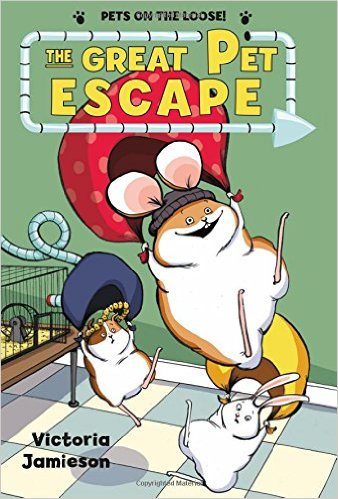


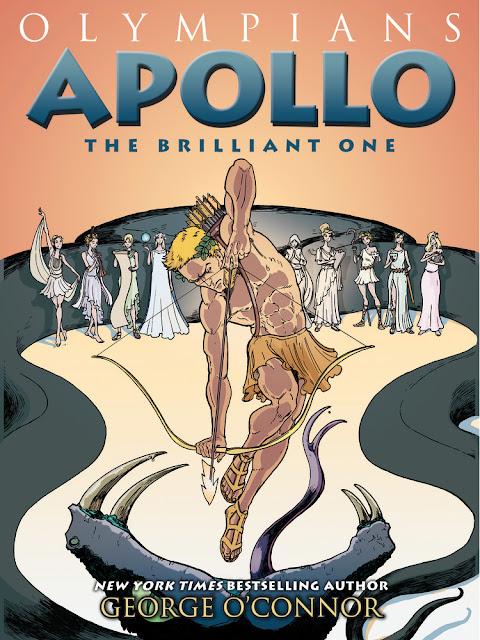




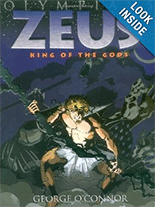
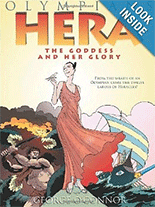



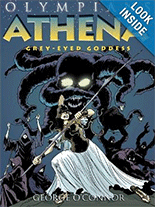



































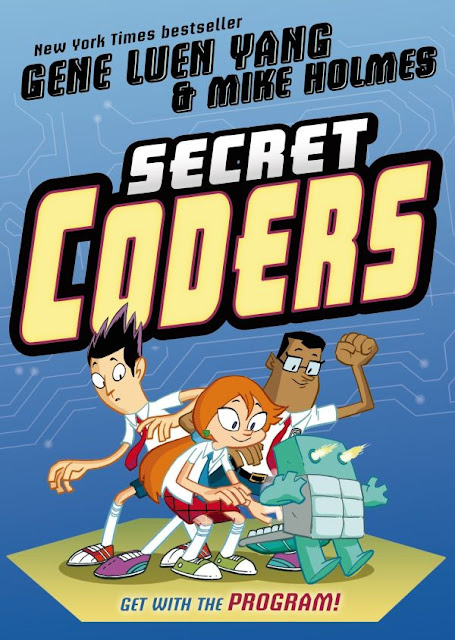

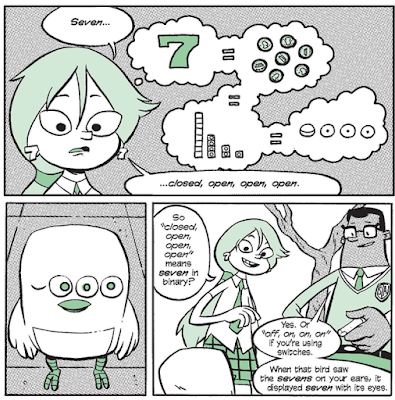



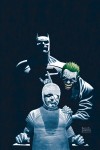 The best works of fiction usually have some basis in reality. Paul Dini is teaming up with Eduardo Risso to tell a Batman story inspired by a mugging in 1993. Dark Knight: A True Batman Story is an original graphic novel told by the two storytellers. The book will be published via DC Comics’ Vertigo […]
The best works of fiction usually have some basis in reality. Paul Dini is teaming up with Eduardo Risso to tell a Batman story inspired by a mugging in 1993. Dark Knight: A True Batman Story is an original graphic novel told by the two storytellers. The book will be published via DC Comics’ Vertigo […]


















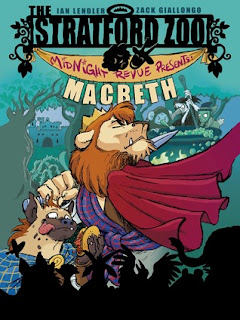













It’s actually “Dark Night,” not “Dark Knight.”